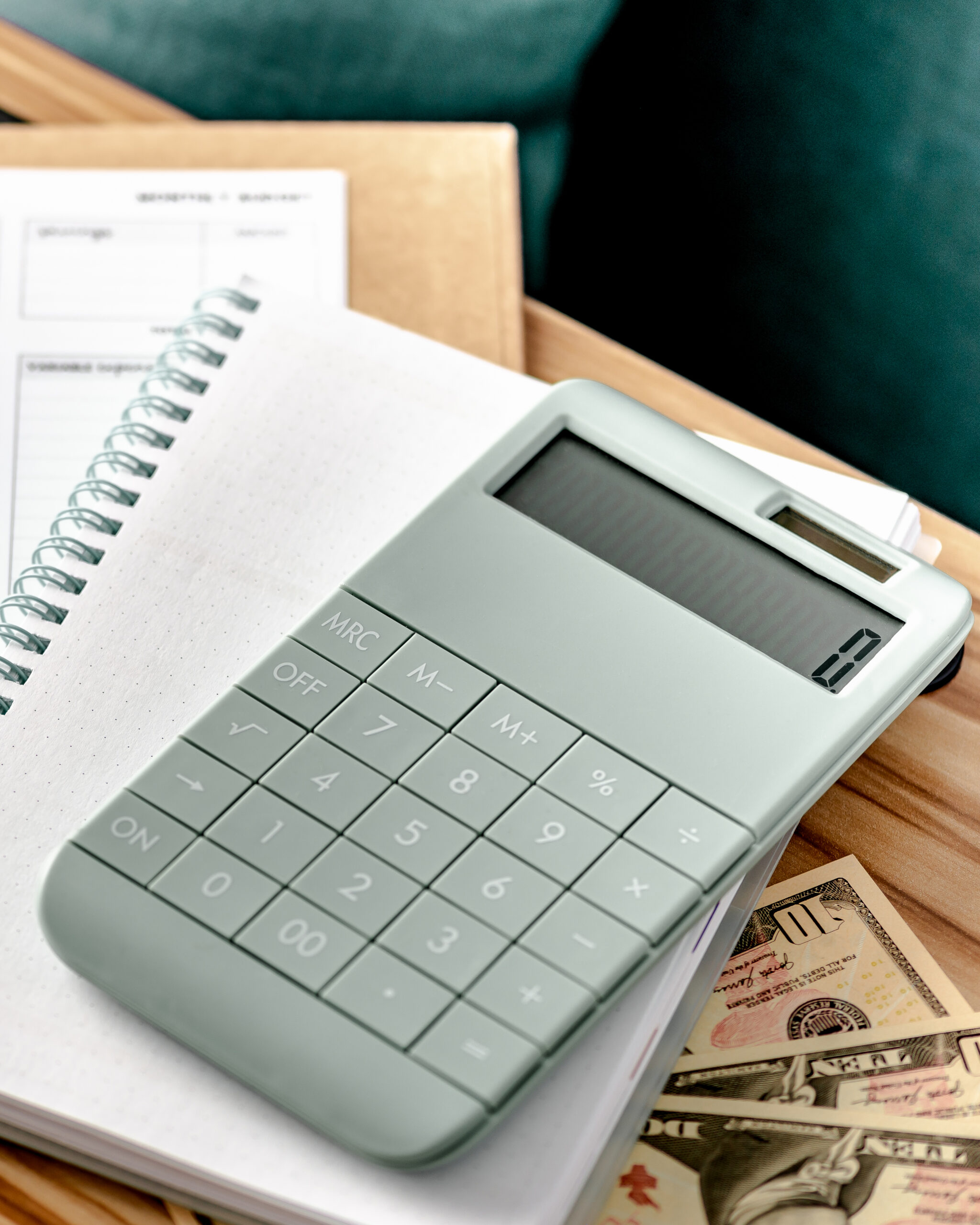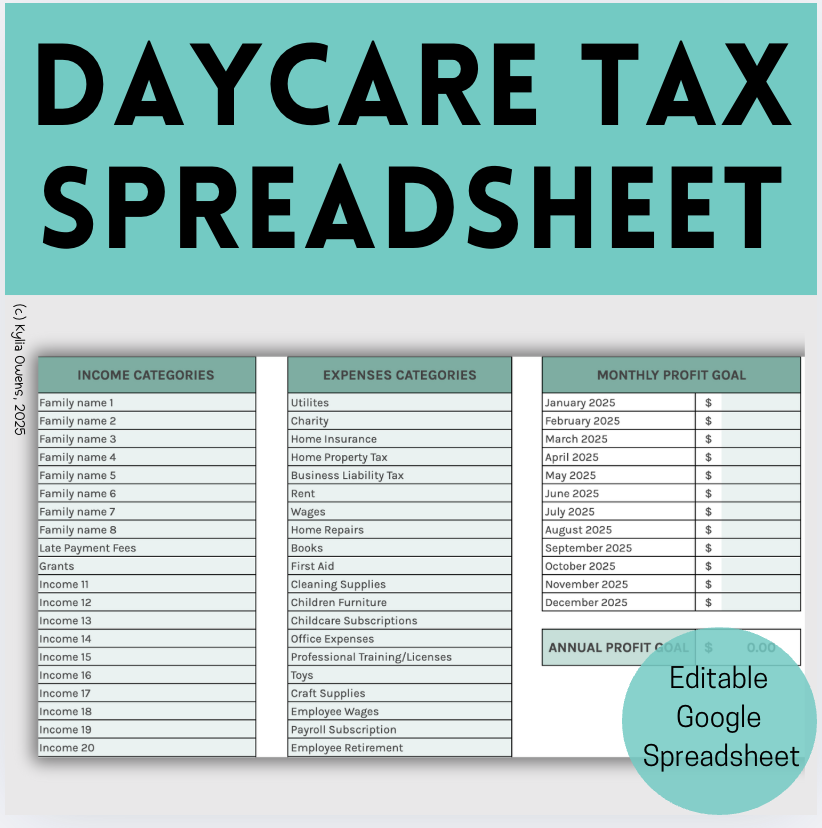This post may contain affiliated links, which means I’ll receive a commission if you purchase through my link, at no extra cost to you. Read the full disclosure statement here.
This blog post is all about home daycare tax deductions.
Tax season is so overwhelming for home daycare providers. What can you actually deduct? How do you keep track of expenses and income? And what on earth is the buzzword time-space percentage?
Do these questions sound familiar? I remember feeling the same way when I first began my daycare journey.
In this guide, I will walk you through everything you need to know about daycare tax deductions and hopefully help you to have a less stressful tax season. This is not tax advice or legal advice, this is my opinion based on my experience and my accountant's advice, seek legal advice.
TAX DEDUCTIONS
Understanding Taxes As A Daycare Provider
Owning a home daycare is a business, making you self-employed, meaning taxes are handled differently than if you were an employee. I think this is one of the upsides to running a home daycare~ tax benefits!
You now have income that you are required by law to report. Which means you have self-employment and income tax to pay. However, keeping track of the expenses from running your business helps offset your taxable income.
Your accountant may want you to pay estimated quarterly taxes so you don't have a large amount to pay at the end of the year. My daycare business has never had to do this due to having enough expenses to offset everything.
Time-Space Percentage What Is It & How It Impacts Your Business
Due to running your business out of your home, you are able to deduct a portion of your household expenses and home repairs in addition to all expenses that are 100% business expenses.
One of the most important things to keep track of in your daycare is your time-space percentage. The time-space percentage determines what percentage are home daycare tax deductions versus personal.
There is a special formula to figure out your time-space percentage. Which requires you to keep careful records to ensure you're getting the full tax write-offs you're allotted.
(Total hours home used for daycare/total hours in year) x (square footage used for daycare/total square footage of home) = time-space percentage=
Example:
- Hours worked with kids 50 hours x 52 weeks = 2600 hours
- Hours worked without kids on business 5 hours x 52 weeks =260 hours
- Hours in a year 24 x 365 = 8,760
- Square footage used for daycare is 1,000 TOTAL square footage of the home is 2,000.
- (2,860/8,760) x (1,000/2,000) = 32.6%
In this example, you could write off 32.6% of expenses that are both personal but used for your home daycare business.
This requires you to keep track of every hour you work with children in your home and when you're working on the business without children. Tom Copeland breaks this down in his book "Family Child-Care Record-Keeping Guide." I HIGHLY suggest you grab this book immediately and read it every year! I still do after twenty years in the home daycare business.
Organizing Taxes
Keeping accurate records is vital as a business owner! You need a way to keep them organized as well. There are many methods and I have most likely tried them all.
I keep all of my receipts and expenses in a basket for the month. On the side of my fridge, I have a calendar where I write the total breakfast, lunch, and snacks I serve each day for the month. I also write the hours I worked outside my normal daycare business hours or any trips I made to get supplies. This helps me track my miles.
What I currently use is a fully editable Childcare Tax Spreadsheet that I created. At the end of every month, I take all of my receipts, utilities, meals served, income, miles, and hours worked and input them into the spreadsheet. Once I have input all of my monthly expenses and income, I then file those receipts in a manila envelope titled the year.
The spreadsheet auto-calculates my total expenses and income based on the categories. It even tracks the total each family paid allowing me to give them proper documentation at the end of the year! It calculates the total annual income, annual meals served, and annual hours worked, has a mileage log, and configures my time-space percentage! I'm then able to print that total annual sheet and hand it over to my accountant!
This is the method I have found that is simple yet efficient. It's simple enough that I stick to it at the end of the month instead of waiting until March and rushing to figure everything out and missing out on tax deductions.
Tax Categories For Business Expenses
In Tom Copeland's book, he discusses the names of the categories aren't as important as knowing what to write off and keeping good records.
I'm going to list a few of the common categories I use and what I put under them. These may not apply to your business nor is this an exhaustive list.
Tax Categories:
- Utilities~ internet, phone, electricity, TV subscriptions, water, trash
- Home Repairs~ anything repaired in the home
- Cleaning Supplies~ laundry detergent, dish soap, dishwasher soap, hand soap, toothpaste and toothbrushes if brushing kids' teeth, disinfectants, trash bags, baggies, toilet paper, paper towels
- Childcare Subscriptions~ educational apps, payment apps
- Professional Development Training & Licensure Fees~ CPR, professional development courses, and licensure fees
- Toys~ toys
- Books~ professional development, children's books and magazines
- Office Expenses~ printers, printer paper, printer ink, printer subscription
- First Aid~ fire extinguishers and inspection fees, first aid supplies
- Craft Supplies~ construction paper, sensory bin items, crayons, markers, glue, tape, paper, pencils, etc
- Home Property Tax~ home property tax
- Business Liability Insurance & Legal Fees~ business insurance, LLC fees etc
- Car Insurance~ explanatory
- Car Property Tax~explanatory
- Car Payments~explanatory
- Car Interest~explanatory
- Car Gas & Maintenance~ gas, oil changes, tires, windshield wipers, any repairs
- Mortgage~ mortgage insurance, property taxes, or renters insurance
- Wages~ employees wages and retirement
- Taxes~ employer paid taxes, accountant fees
- Payroll Subscription~ payroll services fee, checks
Some of these categories are 100% tax deductions while others the time-space percentage will apply. The most important piece is to keep good records. The second most important thing is to keep 100% deductible items out of the time-space percentage categories.
I keep track of miles and all other fees associated with my vehicle because I'm not sure if mileage or standard deduction will benefit my business better until my accountant looks at the whole picture from year to year.
This blog post was all about daycare tax deductions.

